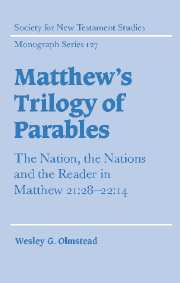Book contents
Appendix - The text of the parable of The Two Sons
Published online by Cambridge University Press: 22 September 2009
Summary
Every verse in the parable of The Two Sons is dotted with textual problems. The most significant, however, is the string of variants that runs through verses 29–31. Although UBS4 lists five variant readings in these verses, three principal alternatives may be isolated, as Table 6 indicates. Readings 1 (NA27 et al.) and 2 (NA25 et al.) introduce the two sons in differing order but they agree that the son who eventually repents and sets out to work has done the father's will. By contrast, the third reading pronounces a blessing upon the son who only promises to work in the vineyard. We begin our discussion with this distinctive third reading.
Reading 3
Though not accepted today by any major critical text or translation, this third reading has not been without eminent proponents. J. R. Michaels has offered one of the most distinctive defences of this reading. He notes first that the parable proper (21.28–31a; ‘saying vs. doing’) and its interpretation (21.31b–32; ‘belief vs. lack of belief’) lack correspondence, but that the interpretation is closely linked in theme to 21.23–27. Second, no less than three key words in the parable are ambiguous. In each case, Michaels abandons the usual understanding, noting that the resulting sense brings the parable into close connection with its context. μεταμέλεσθαι can describe repentance but also a regret that falls short of repentance.
- Type
- Chapter
- Information
- Matthew's Trilogy of ParablesThe Nation, the Nations and the Reader in Matthew 21:28-22:14, pp. 167 - 176Publisher: Cambridge University PressPrint publication year: 2003



